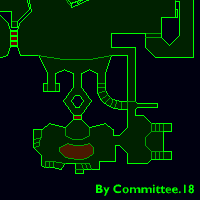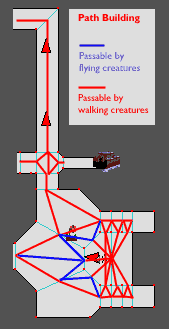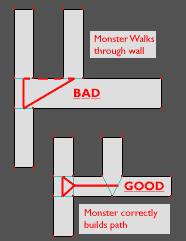Path building in the Marathon engine is simple. Monsters build paths when they get activated, when they switch targets, or when their path becomes obsolete (due to the target moving to a new polygon).
The paths are built between the midpoints of passable sides. Take a quick look at the diagram to the left to see what possible monster paths could be used in a section of By Committee. In other words, when a monster builds a path, he looks at all the passable sides of the polygon that he's in. Then the builds the shortest path to his target through the midpoints of all the polygons that he'll have to traverse. The shortest path is the path that traverses the fewest polygons, not the path that will take the least time. A passable side, is a transparent side that the monster can cross: the side has to be wide enough and the elevation change must be within the monster's parameters (see the notes at the bottom of the page for more information.)
The paths in Red can be used by both walking and flying creatures. The paths usable by flying creatures only are in Blue. (Note that a walking creature can jump off an elevation - the height a monster is willing to jump from is set in the monster's physics model.) In the example, some of the blue paths could be used by walking creatures jumping down.
| 


